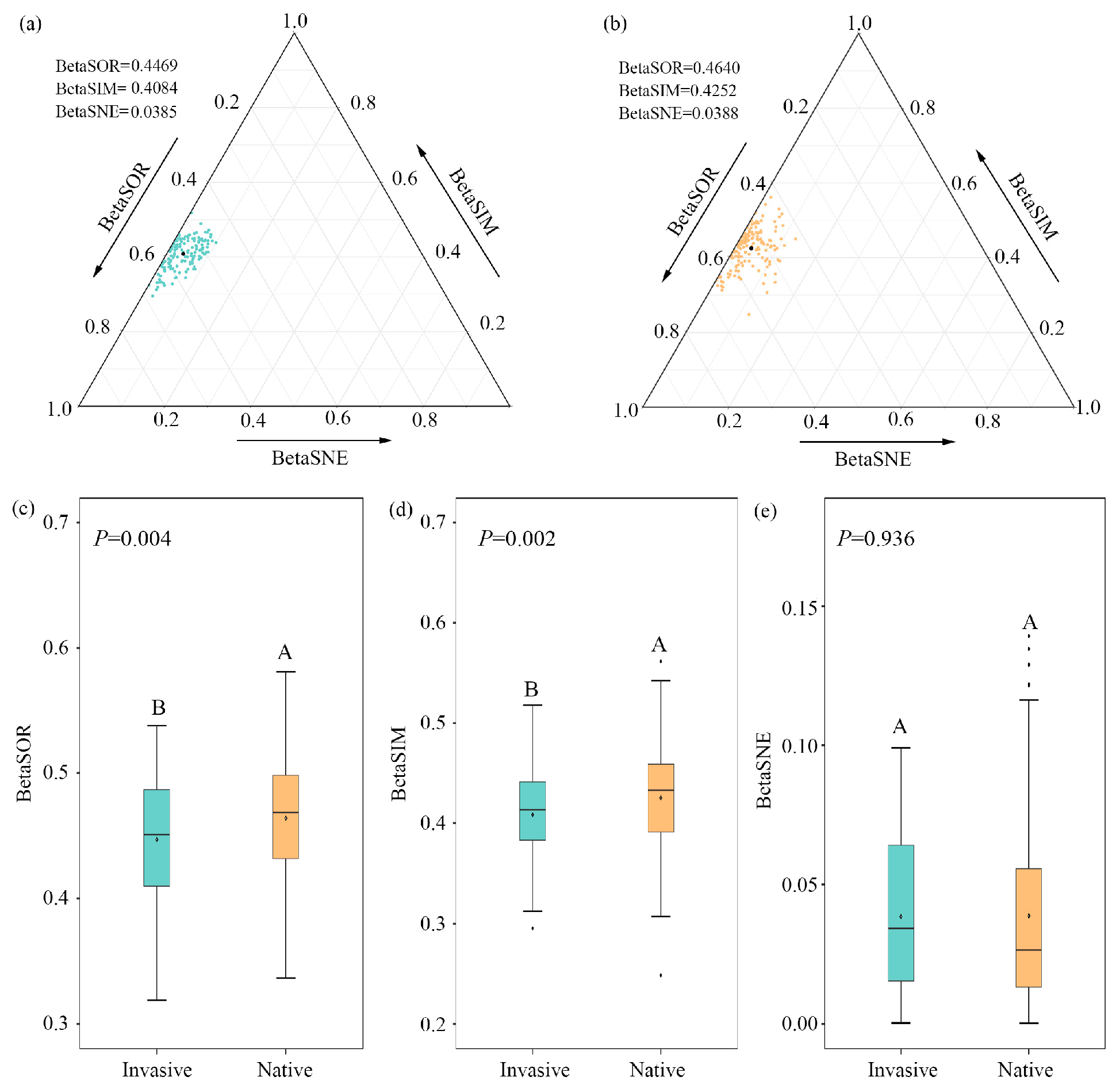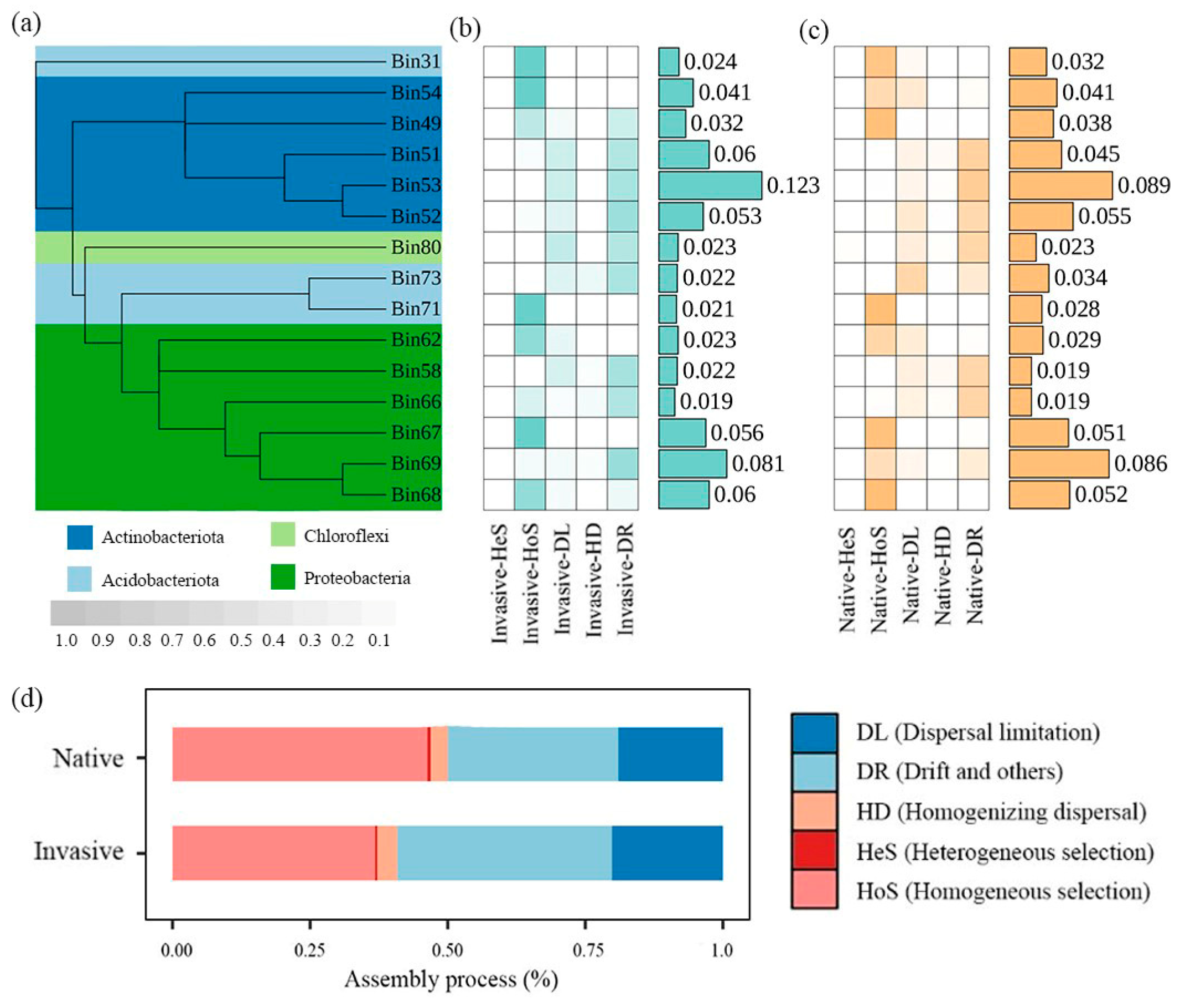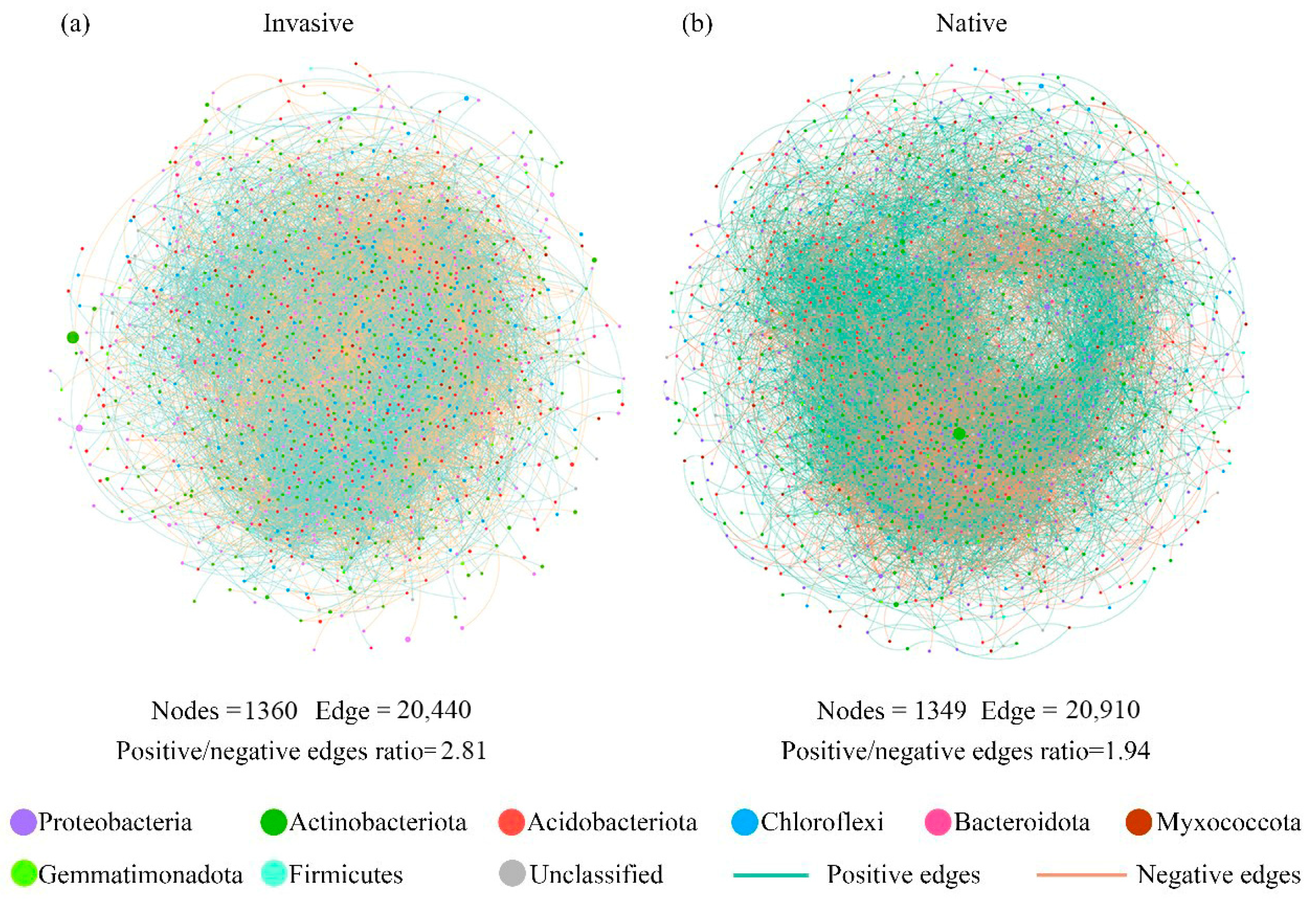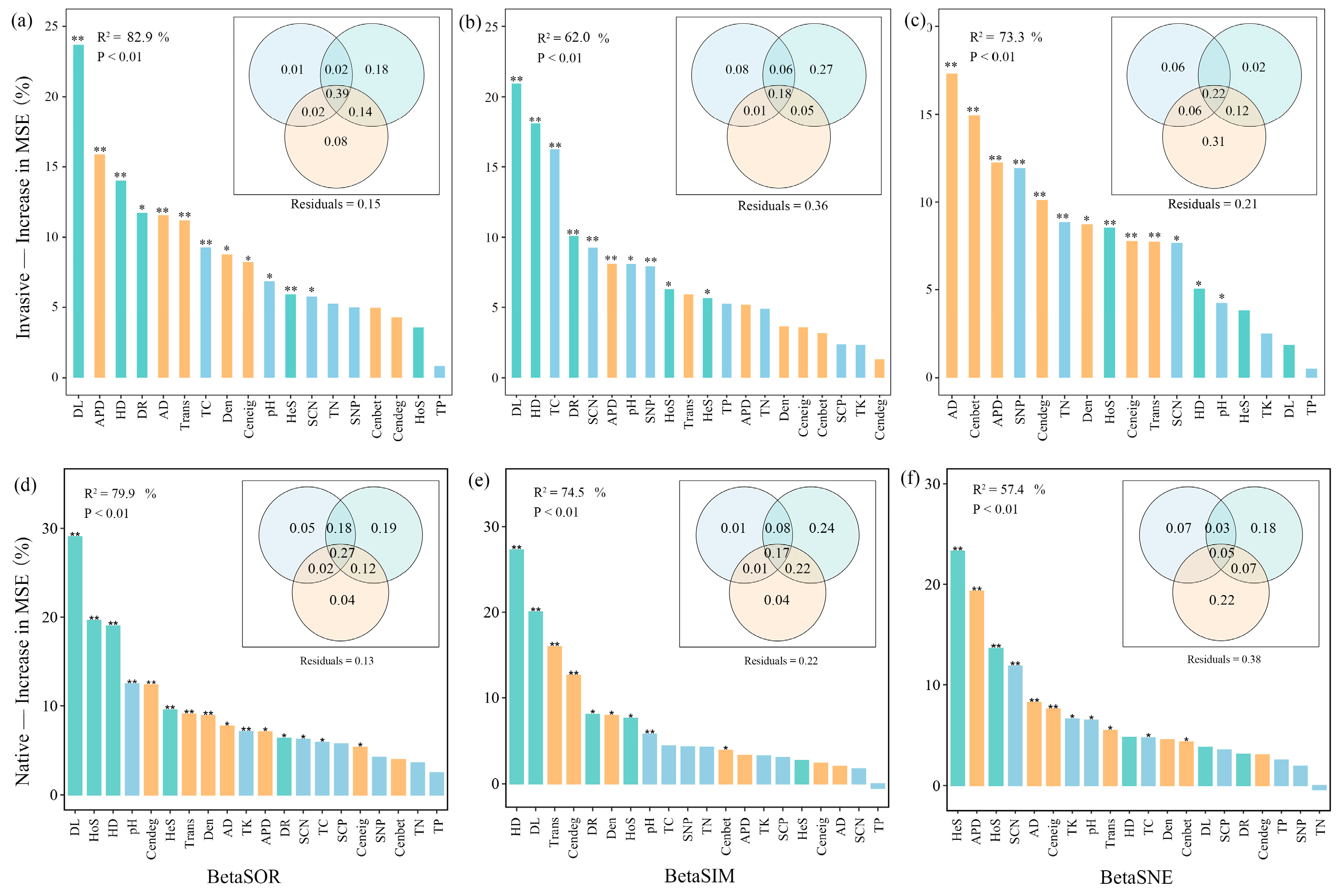Biotic Interactions Shape Soil Bacterial Beta Diversity Patterns along an Altitudinal Gradient during Invasion
Abstract
:1. Introduction
2. Materials and Methods
2.1. Study Area
2.2. Rhizosphere Soil Sampling
2.3. Soil DNA Extraction and Sequencing
2.4. iCAMP Analysis of Community Assembly Processes
2.5. Co-Occurrence Network Construction
2.6. Statistical Analysis
3. Results
3.1. Soil Bacterial Beta Diversity Patterns along Altitudinal Gradients
3.2. Bacterial Assembly Process Based on iCAMP Models
3.3. Biotic Interactions Based on Bacterial Co-Occurrence Patterns
3.4. Underlying Drivers of Soil Bacterial Beta Diversity along Elevational Gradients
4. Discussion
4.1. Beta Diversity Patterns along Altitude Gradient during Invasion
4.2. Assembly Process and Potential Effects on Bacterial Beta Diversity
4.3. Potential Biotic Interaction and Effects on Bacterial Beta Diversity
5. Conclusions
Supplementary Materials
Author Contributions
Funding
Data Availability Statement
Conflicts of Interest
References
- Shi, H.; Zhou, Q.; Xie, F.L.; He, N.J.; He, R.; Zhang, K.R.; Zhang, Q.F.; Dang, H.S. Disparity in elevational shifts of upper species limits in response to recent climate warming in the Qinling Mountains, North-central China. Sci. Total Environ. 2020, 706, 135718. [Google Scholar] [CrossRef] [PubMed]
- Zhou, Y.J.; Jia, X.; Han, L.; Tian, G.; Kang, S.Z.; Zhao, Y.H. Spatial characteristics of the dominant fungi and their driving factors in forest soils in the Qinling Mountains, China. Catena 2021, 206, 105504. [Google Scholar] [CrossRef]
- Zhang, W.X.; Yin, D.; Huang, D.Z.; Du, N.; Liu, J.; Guo, W.H.; Wang, R.Q. Altitudinal patterns illustrate the invasion mechanisms of alien plants in temperate mountain forests of northern China. For. Ecol. Manag. 2015, 351, 1–8. [Google Scholar] [CrossRef]
- Zhang, G.L.; Bai, J.H.; Tebbe, C.; Huang, L.B.; Jia, J.; Wang, W.; Wang, X.; Yu, L.; Zhao, Q.Q. Plant invasion reconstructs soil microbial assembly and functionality in coastal salt marshes. Mol. Ecol. 2022, 31, 4478–4494. [Google Scholar] [CrossRef]
- Custer, G.F.; van Diepen, L.T. Plant invasion has limited impact on soil microbial α-diversity: A meta-analysis. Diversity 2020, 12, 112. [Google Scholar] [CrossRef]
- Tian, C.; Wang, W.Q.; Wang, H.J.; Chen, H.; Tian, J.Q. Plant invasion mediates the regulation of topsoil organic carbon sequestration by the fungal community in coastal wetlands. Catena 2023, 227, 107118. [Google Scholar] [CrossRef]
- Gong, X.; Chen, Y.J.; Wang, T.; Jiang, X.F.; Hu, X.K.; Feng, J.M. Double-edged effects of climate change on plant invasions: Ecological niche modeling global distributions of two invasive alien plants. Sci. Total Environ. 2020, 740, 139933. [Google Scholar] [CrossRef] [PubMed]
- Ding, Z.; Liang, J.; Yang, L.; Wei, C.; Hu, H.; Si, X. Deterministic processes drive turnover-dominated beta diversity of breeding birds along the central Himalayan elevation gradient. Avian Res. 2024, 15, 100170. [Google Scholar] [CrossRef]
- Wang, J.J.; Legendre, P.; Soininen, J.; Yeh, C.F.; Graham, E.; Stegen, J.; Casamayor, E.; Zhou, J.Z.; Shen, J.; Pan, F.Y. Temperature drives local contributions to beta diversity in mountain streams: Stochastic and deterministic processes. Glob. Ecol. Biogeogr. 2020, 29, 420–432. [Google Scholar] [CrossRef]
- Zheng, Y.; Ji, N.N.; Wu, B.; Wang, J.T.; Hu, H.W.; Guo, L.D.; He, J.Z. Climatic factors have unexpectedly strong impacts on soil bacterial β-diversity in 12 forest ecosystems. Soil Biol. Biochem. 2020, 142, 107699. [Google Scholar] [CrossRef]
- Sardans, J.; Bartrons, M.; Margalef, O.; Gargallo-Garriga, A.; Janssens, I.; Ciais, P.; Obersteiner, M.; Sigurdsson, B.; Chen, H.; Peñuelas, J. Plant invasion is associated with higher plant–soil nutrient concentrations in nutrient-poor environments. Glob. Change Biol. 2017, 23, 1282–1291. [Google Scholar] [CrossRef]
- Zhou, J.; Ning, D. Stochastic community assembly: Does it matter in microbial ecology? Microbiol. Mol. Biol. Rev. 2017, 81, e00002-17. [Google Scholar] [CrossRef]
- Bell, J.K.; Siciliano, S.D.; Lamb, E.G. Seasonality and bacterial community assembly processes dominate prairie ecosystem service disruption during invasion. Soil Biol. Biochem. 2023, 184, 109120. [Google Scholar] [CrossRef]
- Aslani, F.; Geisen, S.; Ning, D.; Tedersoo, L.; Bahram, M. Towards revealing the global diversity and community assembly of soil eukaryotes. Ecol. Lett. 2022, 25, 65–76. [Google Scholar] [CrossRef]
- Fan, Q.P.; Liu, K.F.; Wang, Z.L.; Liu, D.; Li, T.; Hou, H.Y.; Zhang, Z.J.; Chen, D.H.; Zhang, S.; Yu, A.L.; et al. Soil microbial subcommunity assembly mechanisms are highly variable and intimately linked to their ecological and functional traits. Mol. Ecol. 2024, 33, e17302. [Google Scholar] [CrossRef] [PubMed]
- Liu, L.; Wang, N.; Liu, M.; Guo, Z.X.; Shi, S.H. Assembly processes underlying bacterial community differentiation among geographically close mangrove forests. mLife 2023, 2, 73–88. [Google Scholar] [CrossRef] [PubMed]
- Chen, X.; Li, H.; Condron, L.M.; Dundield, K.E.; Wakelin, S.A.; Mitter, E.K.; Jiang, N. Long-term afforestation enhances stochastic processes of bacterial community assembly in a temperate grassland. Geoderma 2023, 430, 116317. [Google Scholar] [CrossRef]
- Xu, Z.Y.; Sun, R.H.; He, T.Y.; Sun, Y.Z.; Wu, M.C.; Xue, Y.H.; Meng, F.Q.; Wang, J. Disentangling the impact of straw incorporation on soil microbial communities: Enhanced network complexity and ecological stochasticity. Sci. Total Environ. 2023, 863, 160918. [Google Scholar] [CrossRef]
- Xu, L.; He, N.P.; Li, X.Z.; Cao, H.L.; Li, C.N.; Wang, R.L.; Wang, C.H.; Yao, M.J.; Zhou, S.G.; Wang, J.M. Local community assembly processes shape β-diversity of soil phoD-harbouring communities in the Northern Hemisphere steppes. Glob. Ecol. Biogeogr. 2021, 30, 2273–2285. [Google Scholar] [CrossRef]
- Li, W.J.; Xia, Y.; Li, N.; Chang, J.; Liu, J.; Wang, P.; He, X.W. Temporal assembly patterns of microbial communities in three parallel bioreactors treating low-concentration coking wastewater with differing carbon source concentrations. J. Environ. Sci. 2024, 137, 455–468. [Google Scholar] [CrossRef]
- Liu, C.X.; Zhou, Y.; Qin, H.; Liang, C.F.; Shao, S.; Fuhrmann, J.J.; Chen, J.H.; Xu, Q.F. Moso bamboo invasion has contrasting effects on soil bacterial and fungal abundances, co-occurrence networks and their associations with enzyme activities in three broadleaved forests across subtropical China. For. Ecol. Manag. 2021, 498, 119549. [Google Scholar] [CrossRef]
- Zhang, G.L.; Bai, J.H.; Tebbe, C.; Huang, L.B.; Jia, J.; Wang, W.; Wang, X.; Yu, L.; Zhao, Q.Q. Spartina alterniflora invasions reduce soil fungal diversity and simplify co-occurrence networks in a salt marsh ecosystem. Sci. Total Environ. 2021, 758, 143667. [Google Scholar] [CrossRef]
- Lyu, J.L.; Yue, M.; Mao, Z.X.; Wang, Y.C. Study on Invasion Status and Risk Assessment of Alien Plants in Qinling Mountains. Ecol. Environ. 2023, 32, 1585. [Google Scholar]
- Si, X.; Baselga, A.; Ding, P.; Machado, R.B. Revealing beta-diversity patterns of breeding bird and lizard communities on inundated land-bridge islands by separating the turnover and nestedness components. PLoS ONE 2015, 10, e0127692. [Google Scholar] [CrossRef]
- Wang, X.; Wiegand, T.; Anderson-Teixeira, K.J.; Bourg, N.A.; Hao, Z.; Howe, R.; Jin, G.; Orwig, D.; Spasojevic, M.; Wang, S.; et al. Ecological drivers of spatial community dissimilarity, species replacement and species nestedness across temperate forests. Glob. Ecol. Biogeogr. 2018, 27, 581–592. [Google Scholar] [CrossRef]
- Greve, M.; Gremmen, N.J.M.; Gaston, K.J.; Chown, S.L. Nestedness of Southern Ocean island biotas: Ecological perspectives on a biogeographical conundrum. J. Biogeogr. 2005, 32, 155–168. [Google Scholar] [CrossRef]
- Chase, J.M. Drought mediates the importance of stochastic community assembly. Proc. Natl. Acad. Sci. USA 2007, 104, 17430–17434. [Google Scholar] [CrossRef]
- Stevens, G.C. The elevational gradient in altitudinal range: An extension of Rapoport’s latitudinal rule to altitude. Am. Nat. 1992, 140, 893–911. [Google Scholar] [CrossRef]
- Tang, Z.Y.; Fang, J.Y.; Chi, X.L.; Feng, J.M.; Liu, Y.N.; Shen, Z.H.; Wang, X.P.; Wang, Z.H.; Wu, X.P.; Zheng, C.Y.; et al. Patterns of plant beta-diversity along elevational and latitudinal gradients in mountain forests of China. Ecography 2012, 35, 1083–1091. [Google Scholar] [CrossRef]
- Tang, Z.Y.; Fang, J.Y. Temperature variation along the northern and southern slopes of Mt. Taibai, China. Agric. For. Meteorol. 2006, 139, 200–207. [Google Scholar] [CrossRef]
- Vuille, M.; Bradley, R.S.; Werner, M.; Keimig, F. 20th century climate change in the tropical Andes: Observations and model results. In Climate Variability and Change in High Elevation Regions: Past, Present & Future; Springer: Dordrecht, The Netherlands, 2003; Volume 15, pp. 75–99. [Google Scholar]
- Baselga, A. Disentangling distance decay of similarity from richness gradients: Response to Soininen et al. 2007. Ecography 2007, 30, 838–841. [Google Scholar] [CrossRef]
- Baselga, A.; Gómez-Rodríguez, C. Assessing the equilibrium between assemblage composition and climate: A directional distance-decay approach. J. Anim. Ecol. 2021, 90, 1906–1918. [Google Scholar] [CrossRef]
- Wu, M.H.; Chen, S.Y.; Chen, J.W.; Xue, K.; Chen, S.L.; Wang, X.M.; Kang, S.; Rui, J.; Thies, J.; Bardgett, R.; et al. Reduced microbial stability in the active layer is associated with carbon loss under alpine permafrost degradation. Proc. Natl. Acad. Sci. USA 2021, 118, e2025321118. [Google Scholar] [CrossRef] [PubMed]
- Zinger, L.; Boetius, A.; Ramette, A. Bacterial taxa–area and distance–decay relationships in marine environments. Mol. Ecol. 2014, 23, 954–964. [Google Scholar] [CrossRef] [PubMed]
- Stanek, M.; Zubek, S.; Stefanowicz, A.M. Differences in phenolics produced by invasive Quercus rubra and native plant communities induced changes in soil microbial properties and enzymatic activity. For. Ecol. Manag. 2021, 482, 118901. [Google Scholar] [CrossRef]
- Xu, Z.W.; Guo, X.; Caplan, J.; Li, M.Y.; Guo, W.H. Novel plant-soil feedbacks drive adaption of invasive plants to soil legacies of native plants under nitrogen deposition. Plant Soil 2021, 467, 47–65. [Google Scholar] [CrossRef]
- Zhang, B.; Xue, K.; Zhou, S.T.; Che, R.X.; Du, J.Q.; Tang, L.; Pang, Z.; Wang, F.; Wang, D.; Cui, X.Y.; et al. Environmental selection overturns the decay relationship of soil prokaryotic community over geographic distance across grassland biotas. Elife 2022, 11, e70164. [Google Scholar] [CrossRef]
- Villa, P.M.; Martins, S.V.; DinizÉcio, S.; de Oliveira-Neto, S.N.; Neri, A.V.; Pinto-Junior, H.; Nunes, J.A.; Bueno, M.L.; Ali, A. Taxonomic and functional beta diversity of woody communities along Amazon forest succession: The relative importance of stand age, soil properties and spatial factor. For. Ecol. Manag. 2021, 482, 118885. [Google Scholar] [CrossRef]
- Li, S.; Li, Y.; Hu, C.; Zheng, X.; Zhang, J.; Zhang, H.; Bai, N.; Zhang, H.; Tian, M.; Ban, S.; et al. Stochastic processes drive bacterial and fungal community assembly in sustainable intensive agricultural soils of Shanghai, China. Sci. Total Environ. 2021, 778, 146021. [Google Scholar] [CrossRef]
- Fahey, C.; Koyama, A.; Antunes, P.M.; Dunfield, K.; Flory, S.L. Plant communities mediate the interactive effects of invasion and drought on soil microbial communities. ISME J. 2020, 14, 1396–1409. [Google Scholar] [CrossRef]
- Shen, K.P.; Cornelissen, H.; Wang, Y.J.; Wu, C.B.; He, Y.J.; Ou, J.; Tan, Q.Y.; Xia, T.T.; Kang, L.L.; Guo, Y.; et al. AM fungi alleviate phosphorus limitation and enhance nutrient competitiveness of invasive plants via mycorrhizal networks in karst areas. Front. Ecol. Evol. 2020, 8, 125. [Google Scholar] [CrossRef]
- Luan, L.; Liang, C.; Chen, L.J.; Wang, H.T.; Xu, Q.S.; Jiang, Y.J.; Sun, B. Coupling bacterial community assembly to microbial metabolism across soil profiles. Msystems 2020, 5, e00298-20. [Google Scholar] [CrossRef]
- Huo, X.; Ren, C.J.; Wang, D.X.; Wu, R.Q.; Wang, Y.S.; Li, Z.F.; Huang, D.C.; Qi, H.Y. Microbial community assembly and its influencing factors of secondary forests in Qinling Mountains. Soil Biol. Biochem. 2023, 184, 109075. [Google Scholar] [CrossRef]
- Wang, Y.S.; Li, C.N.; Tu, B.; Kou, Y.P.; Li, X.Z. Species pool and local ecological assembly processes shape the β-diversity of diazotrophs in grassland soils. Soil Biol. Biochem. 2021, 160, 108338. [Google Scholar] [CrossRef]
- Zhang, B.; Xue, K.; Zhou, S.T.; Chen, R.X.; Du, J.Q.; Tang, L.; Pang, Z.; Wang, F.; Wang, D.; Cui, X.Y.; et al. Phosphorus mediates soil prokaryote distribution pattern along a small-scale elevation gradient in Noijin Kangsang Peak, Tibetan Plateau. FEMS Microbiol. Ecol. 2019, 95, fiz076. [Google Scholar] [CrossRef]
- Evans, S.; Martiny, J.B.; Allison, S.D. Effects of dispersal and selection on stochastic assembly in microbial communities. ISME J. 2017, 11, 176–185. [Google Scholar] [CrossRef]
- Liu, W.X.; Yang, X.; Jaing, L.; Guo, L.L.; Chen, Y.R.; Yang, S.; Liu, L.L. Partitioning of beta-diversity reveals distinct assembly mechanisms of plant and soil microbial communities in response to nitrogen enrichment. Ecol. Evol. 2022, 12, e9016. [Google Scholar] [CrossRef]
- Fetzer, I.; Johst, K.; Schäwe, R.; Banitz, T.; Harms, H.; Chatzinotas, A. The extent of functional redundancy changes as species’ roles shift in different environments. Proc. Natl. Acad. Sci. USA 2015, 112, 14888–14893. [Google Scholar] [CrossRef]
- Marini, L.; Bertolli, A.; Bona, E.; Federici, G.; Martini, F.; Prosser, F.; Bommarco, R. Beta-diversity patterns elucidate mechanisms of alien plant invasion in mountains. Glob. Ecol. Biogeogr. 2013, 22, 450–460. [Google Scholar] [CrossRef]
- Bertuzzi, T.; Marques Pires, M.; Maltchik, L. Drivers of the beta diversity of aquatic plant communities along a latitudinal gradient in southern Brazilian coastal ponds. J. Veg. Sci. 2019, 30, 281–290. [Google Scholar] [CrossRef]
- Fu, H.; Yuan, G.X.; Jeppesen, E.; Ge, D.B.; Li, W.; Zou, D.S.; Huang, Z.R.; Wu, A.P.; Liu, Q.L. Local and regional drivers of turnover and nestedness components of species and functional beta diversity in lake macrophyte communities in China. Sci. Total Environ. 2019, 687, 206–217. [Google Scholar] [CrossRef]
- de Camargo, N.F.; de Oliveira, H.F.M.; Ribeiro, J.F.; de Camargo, A.J.A.; Vieira, E.M. Availability of food resources and habitat structure shape the individual-resource network of a Neotropical marsupial. Ecol. Evol. 2019, 9, 3946–3957. [Google Scholar] [CrossRef]
- Lin, Q.; Li, L.; Adams, J.; Heděnec, P.; Tu, B.; Li, C.; Li, T.; Li, X. Nutrient resource availability mediates niche differentiation and temporal co-occurrence of soil bacterial communities. Appl. Soil Ecol. 2021, 163, 103965. [Google Scholar] [CrossRef]
- Fahey, C.; Flory, S.L. Soil microbes alter competition between native and invasive plants. J. Ecol. 2022, 110, 404–414. [Google Scholar] [CrossRef]
- Zhang, X.; van Kleunen, M.; Chang, C.L.; Liu, Y.J. Soil microbes mediate the effects of resource variability on plant invasion. Ecology 2023, 104, e4154. [Google Scholar] [CrossRef]
- Wayne, W.; Schrama, M. Identifying the role of soil microbes in plant invasions. J. Ecol. 2016, 104, 1211–1218. [Google Scholar]
- Qiu, L.P.; Zhang, Q.; Zhu, H.S.; Reich, P.B.; Banerjee, S.; Heijden, M.; Sadowsky, M.J.; Ishii, S.; Jia, X.X.; Shao, M.A.; et al. Erosion reduces soil microbial diversity, network complexity and multifunctionality. ISME J. 2021, 15, 2474–2489. [Google Scholar] [CrossRef]
- Xu, M.; Li, X.L.; Kuyper, T.; Xu, M.; Li, X.L.; Zhang, J.L. High microbial diversity stabilizes the responses of soil organic carbon decomposition to warming in the subsoil on the Tibetan Plateau. Glob. Change Biol. 2021, 27, 2061–2075. [Google Scholar] [CrossRef]
- Huang, Y.; Zhang, X.; Fu, S.; Zhang, W. Environmental filtering drives local soil fungal beta diversity more than dispersal limitation in six forest types along a latitudinal gradient in Eastern China. Forests 2019, 10, 863. [Google Scholar] [CrossRef]
- Lei, S.L.; Wang, X.T.; Wang, J.; Zhang, L.; Liao, L.R.; Liu, G.B.; Wang, G.L.; Song, Z.L.; Zhang, C. Effect of aridity on the β-diversity of alpine soil potential diazotrophs: Insights into community assembly and co-occurrence patterns. Msystems 2024, 9, e01042-23. [Google Scholar] [CrossRef]
- Lee, H.; Bloxham, B.; Gore, J. Resource competition can explain simplicity in microbial community assembly. Proc. Natl. Acad. Sci. USA 2023, 120, e2212113120.3. [Google Scholar] [CrossRef]
- Jiao, S.; Chu, H.Y.; Zhang, B.G.; Wei, X.R.; Chen, W.M.; Wei, G.H. Linking soil fungi to bacterial community assembly in arid ecosystems. iMeta 2022, 1, e2. [Google Scholar] [CrossRef] [PubMed]






Disclaimer/Publisher’s Note: The statements, opinions and data contained in all publications are solely those of the individual author(s) and contributor(s) and not of MDPI and/or the editor(s). MDPI and/or the editor(s) disclaim responsibility for any injury to people or property resulting from any ideas, methods, instructions or products referred to in the content. |
© 2024 by the authors. Licensee MDPI, Basel, Switzerland. This article is an open access article distributed under the terms and conditions of the Creative Commons Attribution (CC BY) license (https://creativecommons.org/licenses/by/4.0/).
Share and Cite
Wang, Y.; Xue, W.; Lyu, J.; Yue, M.; Mao, Z.; Shen, X.; Wang, X.; Li, Y.; Li, Q. Biotic Interactions Shape Soil Bacterial Beta Diversity Patterns along an Altitudinal Gradient during Invasion. Microorganisms 2024, 12, 1972. https://doi.org/10.3390/microorganisms12101972
Wang Y, Xue W, Lyu J, Yue M, Mao Z, Shen X, Wang X, Li Y, Li Q. Biotic Interactions Shape Soil Bacterial Beta Diversity Patterns along an Altitudinal Gradient during Invasion. Microorganisms. 2024; 12(10):1972. https://doi.org/10.3390/microorganisms12101972
Chicago/Turabian StyleWang, Yuchao, Wenyan Xue, Jinlin Lyu, Ming Yue, Zhuxin Mao, Xuejian Shen, Xue Wang, Yang Li, and Qian Li. 2024. "Biotic Interactions Shape Soil Bacterial Beta Diversity Patterns along an Altitudinal Gradient during Invasion" Microorganisms 12, no. 10: 1972. https://doi.org/10.3390/microorganisms12101972





